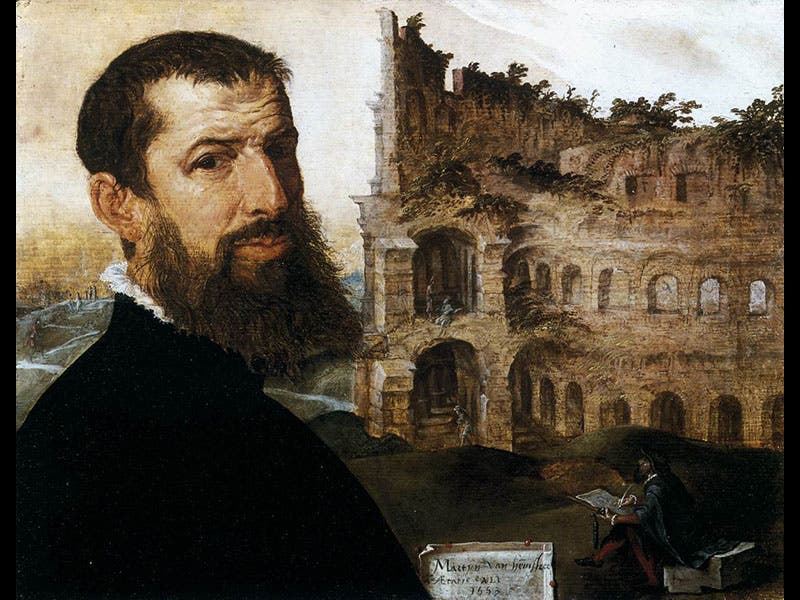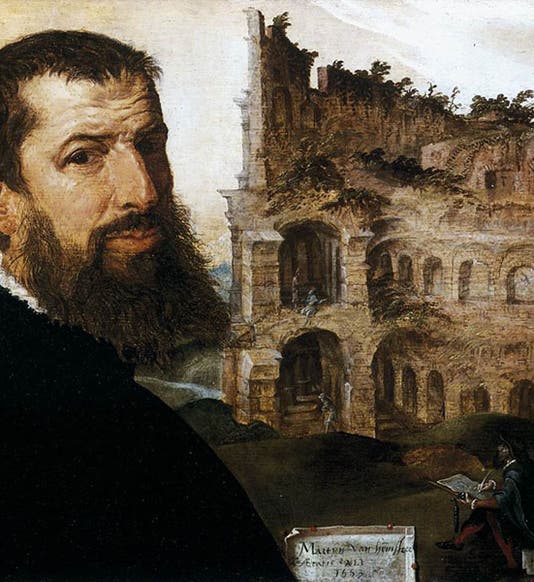Scientist of the Day - Maerten van Heemskerck





Maerten van Heemskerck, a Dutch artist, was born June 1, 1498. Heemskerck was noted for his paintings, his prints, and his sketchbook, and the sketches are what earn him entry into our scientific space. Heemskerck spent four years in Italy, from 1532-36, and unlike any of his Dutch predecessors, Heemskerck was fascinated by the ruins and antiquities of ancient Rome, and he drew them incessantly. We see above his drawing of the forum of Nerva (second image) and his sketch of one of the more notable pieces of unearthed antique sculpture, the Belvedere torso (third image). Even for the one self-portrait that he executed in Italy, he posed himself before the Roman Colosseum (first image). Heemskerck was the first Northern archaeological artist, and if one grants that archaeology is a science, Heemskerck easily qualifies as a scientist of the day.
Heemskerck also made a small contribution to the history of technology by publishing a series of prints depicting the Seven Wonders of the Ancient World, such as the Pharos at Alexandria and the Mausoleum at Halicarnassus (fourth image). These tend to be rather fanciful, but we should remember that virtually no one in the Renaissance besides Heemskerck was making any effort to try to reconstruct the archaeology and technology of the ancient world.
Our favorite Heemskerck print, also relevant for this space, has a completely different theme. It is called, if we go by the title at the top, Tempus ridendi, Tempus flendi—A Time to Laugh, a Time to Weep--a quotation from Ecclesiastes that you might recognize from either the Old Testament or the Pete Seeger/Byrds song. The print is often called Heraclitus and Democritus, from the two characters who are standing around pointing at the earth-orb between. Heraclitus and Democritus were both pre-Socratic natural philosophers. Heraclitus was intrigued by the fact that the world is ever changing yet always the same (“you can never step twice into the same river,” is the way he put it), while Democritus was the father of atomism. But in late antiquity, they became known for different reasons; Heraclitus was called the Weeping Philosopher, because he wept at the folly of humankind, while Democritus was the Laughing Philosopher, regarding the human condition with mocking derision. Appropriately, the world between them here wears a fool’s cap; Democritus points at it and laughs, while Heraclitus wipes away his tears with his robe.
Heemskerck had his own ideas about how to deal with human foolishness and misery, as he tells us in the bottom oval cartouche: “Neither shed tears like Heraclitus, nor roar with laughter like Democritus; instead, endure and forbear.” Spoken like a true Stoic, as Heemskerck probably was.
Dr. William B. Ashworth, Jr., Consultant for the History of Science, Linda Hall Library and Associate Professor, Department of History, University of Missouri-Kansas City. Comments or corrections are welcome; please direct to ashworthw@umkc.edu.






